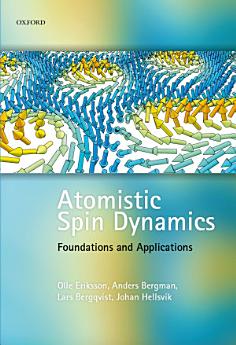Atomistic Spin Dynamics: Foundations and Applications
2017 ഫെബ്രു · Oxford University Press
ഇ-ബുക്ക്
248
പേജുകൾ
family_home
യോഗ്യതയുണ്ട്
info
reportറേറ്റിംഗുകളും റിവ്യൂകളും പരിശോധിച്ചുറപ്പിച്ചതല്ല കൂടുതലറിയുക
ഈ ഇ-ബുക്കിനെക്കുറിച്ച്
The purpose of this book is to provide a theoretical foundation and an understanding of atomistic spin-dynamics (ASD), and to give examples of where the atomistic Landau-Lifshitz-Gilbert equation can and should be used. As argued in the text, a description of magnetism in an atomistic way is very natural and allows for an interpretation of experimental results in a clear and deep way. This description also allows for calculations, from first principles, of all parameters needed to perform the spin-dynamics simulations, without using experimental results as input to the simulations. As shown in the book, we are now at a very exciting situation, where it is possible to perform accurate and efficient atomistic simulations on a length- and time-scale which is balancing on the edge of what is experimentally possible. In this way, ASD simulations can both validate and be validated by state-of-the art experiments, and ASD simulations also have the possibility to act as a predictive tool that is able to explain the magnetization dynamics in experimentally inaccessible situations. The purpose of this book has been to communicate technically relevant concepts. An even larger motivation is to communicate an inspiration to magnetism and magnetization dynamics, and the emerging technological fields that one may foresee, e.g. in magnonics, solitonics and skyrmionics.
രചയിതാവിനെ കുറിച്ച്
Olle Eriksson received his PhD at the Physics Department, Uppsala University, in 1989. After spending three years in Los Alamos as a post doc he returned to the Physics Department, Uppsala University in 1992 where, he has worked ever since. Eriksson's research interests lies in materials theory, electronic structure theory, correlated electron physics, as well as theory of magnetism and magnetic materials. He has been active in this field for over thirty years. Eriksson received a chair professorship in Theoretical Magnetism, in 2002. Anders Bergman received his PhD in Physics at Uppsala University in 2006 on the subject of magnetic properties in nanostructured materials. After the PhD he has had postdoc positions at CEA Grenoble, France, KTH Royal Institute of Technology, Stockholm and at Uppsala University. Currently Dr. Bergman is a researcher at Uppsala University where his main topics includes method development of electronic structure calculations and numerical studies of the magnetization dynamics of low-dimensional systems, topological magnets and chiral magnetis and related systems relevant for information processing applications. Lars Bergqvist received his Ph D in physics at Uppsala University 2005. He was a postdoc at Research Center Julich, Germany between 2005-2009, assistant professor at Uppsala University between 2009-2010 and since 2010 situated at KTH Royal Institute of Technology. His present research interests are energy efficient materials, in particular thermoelectrics, and magnetization dynamics in low dimensional and bulk systems with special focus on method development of finite-temperature magnetism. Johan Hellsvik received his PhD in physics from Uppsala University in 2011. He has been a postdoc at CNR-SPIN, L'Aquila, and at ISC-CNR Sapienza, Rome. Early research projects involved studies on the spin dynamics of spin glasses and diluted magnetic semiconductors. His present research activity is on the topics of multiferroic materials, ultrafast magnetization dynamics, and frustrated magnetism.
ഈ ഇ-ബുക്ക് റേറ്റ് ചെയ്യുക
നിങ്ങളുടെ അഭിപ്രായം ഞങ്ങളെ അറിയിക്കുക.
വായനാ വിവരങ്ങൾ
സ്മാർട്ട്ഫോണുകളും ടാബ്ലെറ്റുകളും
Android, iPad/iPhone എന്നിവയ്ക്കായി Google Play ബുക്സ് ആപ്പ് ഇൻസ്റ്റാൾ ചെയ്യുക. ഇത് നിങ്ങളുടെ അക്കൗണ്ടുമായി സ്വയമേവ സമന്വയിപ്പിക്കപ്പെടുകയും, എവിടെ ആയിരുന്നാലും ഓൺലൈനിൽ അല്ലെങ്കിൽ ഓഫ്ലൈനിൽ വായിക്കാൻ നിങ്ങളെ അനുവദിക്കുകയും ചെയ്യുന്നു.
ലാപ്ടോപ്പുകളും കമ്പ്യൂട്ടറുകളും
Google Play-യിൽ നിന്ന് വാങ്ങിയിട്ടുള്ള ഓഡിയോ ബുക്കുകൾ കമ്പ്യൂട്ടറിന്റെ വെബ് ബ്രൗസർ ഉപയോഗിച്ചുകൊണ്ട് വായിക്കാവുന്നതാണ്.
ഇ-റീഡറുകളും മറ്റ് ഉപകരണങ്ങളും
Kobo ഇ-റീഡറുകൾ പോലുള്ള ഇ-ഇങ്ക് ഉപകരണങ്ങളിൽ വായിക്കാൻ ഒരു ഫയൽ ഡൗൺലോഡ് ചെയ്ത് അത് നിങ്ങളുടെ ഉപകരണത്തിലേക്ക് കൈമാറേണ്ടതുണ്ട്. പിന്തുണയുള്ള ഇ-റീഡറുകളിലേക്ക് ഫയലുകൾ കൈമാറാൻ, സഹായ കേന്ദ്രത്തിലുള്ള വിശദമായ നിർദ്ദേശങ്ങൾ ഫോളോ ചെയ്യുക.




